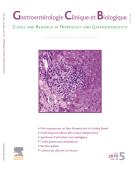Increased oro-cecal transit time in grade I or II hepatic encephalopathy - 29/02/08
Mickael Bouin [1],
Catherine Vincent [1],
Karine Bouhier [1],
Danièle Debruyne [1],
Armelle Fatome [1],
Marie-Astrid Piquet [1],
Jean-Claude Verwaerde [1],
Thong Dao [1]
Mostrare le affiliazioniAugmentatioin du temps de transit oro-caecal dans l'encéphalopathie hépatique de stade I ou II |
La physiopathologie de l'encéphalopathie hépatique est mal connue. Il a été suggéré qu'un trouble moteur digestif pourrait favoriser le passage systémique de substances intraluminales et ainsi favoriser l'encéphalopathie hépatique.
But |
Mesurer le temps de transit oro-caecal chez les malades cirrhotiques sans ou avec encéphalopathie hépatique.
Matériel et méthodes |
Etaient inclus les malades hospitalisés présentant une cirrhose alcoolique sans ou avec encéphalopathie hépatique d'étiologique indéterminée et de stade I ou II. Le temps de transit oro-caecal a été mesuré par le test à la salazopyrine chez les malades et 9 volontaires sains. La gravité de l'encéphalopathie et de la cirrhose (score de Child-Pugh) ont été évaluées.
Résultats |
Vingt-huit malades (âge moyen 62,5 ± 8,5 ans) ont été inclus. Dix-huit n'avaient pas d'encéphalopathie hépatique et 10 présentait une encéphalopathie hépatique sans cause retrouvée. Le temps de transit oro-caecal était significativement plus élevé dans le groupe encéphalopathie hépatique (641 ± 350 min) que dans le groupe sans encéphalopathie hépatique (298 ± 96; P ≪ 0,05) et le groupe témoins (354 ± 90; P ≪ 0,05). Le temps de transit oro-caecal n'était pas influencé par la gravité de la cirrhose et le grade de l'encéphalopathie hépatique.
Conclusion |
Les malades avec une cirrhose alcoolique avec encéphalopathie hépatique ont un temps de transit oro-caecal allongé. Cette anomalie motrice digestive pourrait expliquer un certain nombre d'encéphalopathies hépatiques dites idiopathiques.
The pathogenic mechanisms of hepatic encephalopathy remain to be elucidated. It has been suggested that a digestive motor disorder could promote the absorption of toxins produced within the lumen and thus enhance hepatic encephalopathy.
Aim |
To evaluate oro-cecal transit time in cirrhotic patients with and without hepatic encephalopathy.
Methods |
Hospitalized patients with alcoholic cirrhosis without encephalopathy and with spontaneous grade I and II encephalopathy were included. Severity of hepatic encephalopathy was assessed clinically and the Child-Pugh score was used to describe cirrhosis severity. Nine healthy volunteers constituted a control group. Oro-cecal transit time was measured with the sulfasalazine test.
Results |
Twenty-eight patients (mean age 62.5 ± 8.5 years) were included. Ten had hepatic encephalopathy of unknown cause and 18 were free of hepatic encephalopathy. Oro-cecal transit time was significantly longer in patients with hepatic encephalopathy (641 ± 350 min) compared to patients without hepatic encephalopathy (298 ± 96; P ≪ 0.05) and to controls (354 ± 90; P ≪ 0.05). Oro-cecal transit time was comparable for each Child-Pugh score and was not different between the two grades of hepatic encephalopathy.
Conclusion |
Oro-cecal transit time is longer in alcoholic cirrhosis patients with hepatic encephalopathy. This digestive motor disorder provides a partial explanation of hepatic encephalopathy of unknown etiology.
Mappa
© 2004 Elsevier Masson SAS. Tous droits réservés.
Vol 28 - N° 12
P. 1240-1244 - Dicembre 2004 Ritorno al numeroBenvenuto su EM|consulte, il riferimento dei professionisti della salute.

